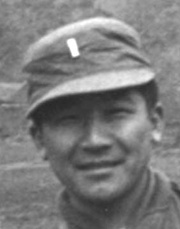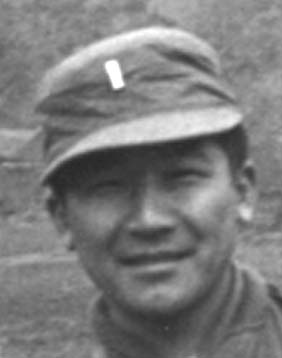
Banco de Dados da Experiência Militar Nipo-Americana

Sukeo "Skeets" Oji
Williams Field, AZ
442nd Regimental Combat Team, Company D, 1st Battalion, Camp Shelby, MS
Military Intelligence Services Language School, Ft. Snelling, MN
Infantry School, Ft. Benning, GA
583rd Engineer Construction Group, Sendai, Japan
Camp Pickett, VA
Ft. Belvoir, VA
Taegu, Korea
POW Training School - Pusan, Korea
G-2 General Headquarters, Tokyo, Japan
Engineer Section Headquarters, 6th Army, Presidio of San Francisco, CA
Japan Construction Agency, Tokyo, Japan
G-4 Headquarters, 6th U.S. Army, Presidio of San Francisco, CA
Hanau, Germany
Post Engineer of Artillery and Tank Training Center, Baumholder, Germany
Sierra Army Depot, Herlong CA
Military Intelligence
MIS (Japanese) Interpreter/translator officer.
Other Countries: Sendai, Japan; Taegu, Korea; Pusan, Korea; Tokyo, Japan; Hanau, Germany; Baumholder, Germany
MILS -Translation and Interpretation
Construction
Staff officer
Intelligence Officer
Liaison Officer
Offensive Drive across 38th parallel; Dec '50 - April '51 Wonju, Korea
Army Commendation Medal
Expert Infantryman Badge
Good Conduct Medal
American Campaign Medal
American Defense Service Medal
World War II Victory Medal
Army of Occupation Medal (Japan)
Armed Forces Reserve Medal
National Defense Service Medal
United Nations Service Medal
Korean Service Medal
Republic of Korea Presidential Unit Citation Badge
Either bathed from helmets or in nearby streams or village residence bath.
We had a good Kibei soldier cook. Lots of rice - local kimchi - GI ration - Fellows on leave to Japan brought Japanese canned goods.
Not much entertainment - card games - out in front line, you don't get much - lots of excitement, however.
Mr. Sukeo 'Skeets' Oji has written an autobiography which is available through the Museum Staff. Some material is excerpted and presented here.
I was born and raised on a farm in Sacramento, CA and graduated from Sacramento High School in February 1936. I continued my education at Sacramento Junior College and graduated in June 1940.
During college, I was accepted into the Civilian Pilot Training Program and earned my Private Pilot License. I had a short stint with acrobatic and cross country flying.
I was drafted on November 6, 1941 and was assigned to the 554th Air Squadron at Moffett Field, CA. In January 1942 the unit was transferred to Williams Field, AZ. One day I was escorted by the MP's to the post brig as a prisoner, for obvious reasons, until diposition was made. I will always remember my First Sgt Green, who vouched for me and took me back to the company to await orders. The Army transferred me to inactive reserve and told me to go home in February 1942.
In early April 1942, we were evacuated to Tulare Assembly Center and then to Gila Relocation Center. I received my acceptance to attend University of Nebraska, shortly thereafter, to continue my education. In September 1943, at the end of my junior year, I was recalled to active duty and assigned to Company D, 1st Battalion, 442nd RCT, where as Sgt, I was assigned as Heavy Machine Gun Squad Leader. When orders for overseas movement came in April 1944, all the non-coms stayed behind and formed the 78th Training Battalion.
I applied and was accepted for Military Intelligence Services Language School on August 1944 and graduated in June 1945. I applied for Officer's Candidate School and was accepted in July 1945.
By this time, the European War was over and in August 1945, with the bombing of Hiroshima, war ended with Japan before we graduated on October 1945. After receiving my commission, I was assigned to the Occupation of Japan.
I was assigned to 164th Language Detachment and temporarily detailed to 1st Brigade, 1st Calvary Division in Tokyo. After two months, the 164th Language Detachment was reassigned to HQ, IX Corps in Sendai. Soon after I transferred to the 583rd Engineer Construction Groupp as they needed a Japanese speaking Engineer Officer. I was in charge of about 30 Japanese engineers, preparing enginnering and construction plans for a complete 3000 man cantonment and 600 dependent family housing units on the former site of the Imperial Japanese 2nd Division Army HQ, which was totally demolished.
In May 1948, I rotated back to the States to Camp Pickett, VA, as assistant Post Engineer. After attending the Advanced Associated Engineer Officers course at Ft. Belvoir, VA, I was assigned to the 185th Engineer Combat Bn. at Camp Campbell, KY, rebuilding permanent rifle ranges in the 3rd Army area. Due to my linguistic background, I was reasssigned to Sendai, Japan in February 1950, to construct additional dependent family housing.
The Korean War broke out on June 25, 1950. A month later I received a call from Capt. K.K. Sakamoto, 8th Army Yokohama and was temporarily attached to 166th Military Intelligence Service Detachment to form an Interrogation Prisoner of War Team. By then, our four understrength US divisions from Japan were forced to withdraw to the banks of the Naktong River, known as the Pusan Perimeter. We finally held when our 2nd Infantry Division was committed together with the 1st Marine Division from Camp Pendleton and the 5thRCT from Hawaii, in early August. Being on the defensive, we did not get many prisoners.
With the successful landing at Inchon and weakening of the enemy, due to their over extended supply line, we started our offensive on September 1950. We pushed north rapidly with little resistance. During this offensive we captured thousands of prisoners. We identified and tagged all of them but only interrogated key non-coms and officers.
In early October, we became aware that the communist Chinese Army were infiltrating across the Yalu River, when we started to get Chinese prisoners. This caused a dilema because we were assigned a Russian linguist but no Chinese. 8th Army realizing this dilema, had MacArthur's HQ go to Chiang Kai Shek for help to hire Chinese-English linguists. They were assigned only down to the Corps level to insure they were not captured.
As feared, On November 29th, the Communist Chinese Army launched a full scale attack on all fronts. The ROK II Corps on our right front collapsed and we got our pants kicked off from their onslaught. 2nd Division, being on the right flank was ordered to hold at all cost until our forces on the left withdrew safely.
By this time, two Chinese regiments maneuvered to our rear and we had to fight through this road block. I lost two of my men. Our Division experienced such heavy losses that we had to recuperate for over a month in the rear.
In early February 1951, we started to experience rapid attrition of our Nisei linguists as many had high rotation points to go home. In April 1951, as a stop gap measure I was called back to HQ, 8th Army, in Taegu, by Capt. K.K. Sakamoto to establish an Interogation Prisoner of War Training School at Army Prison Compound in Pusan, Korea to train replacements. I pulled Nisei soldiers from the front line for a two week intensive training program. By the time I was eligible to rotate home in June 1951, I accomplished my mission of filling the front line teams with replacements. I was promoted to Capt. and rotated back to the States and assigned to Engineer Section, HQ, 6th Army, Presidio of San Francisco, CA. I served as Engineer Staff Officer in the Installation Planning and Construction Programming Division for the next three years.
In July 1954, I was reassigned to Japan with the Japan Construction Agency, US Forces Japan in Tokyo. I served as Liaison Officer between the US Army Forces and the Japanese Ministry of Construction in a $50 million Japanses Government Relocation Construction Program for use of US Forces, Japan. This program relocated the US Forces to their own facilities and returned the civilian office buildings and facilities back to the economy. The directive was promulgated by J4, Far East Command and the Japanese Government. Capt. Gene Uratsu was the liaison officer. Incidentally we were roommates at the Yuraku Officers billet until our families joined us. Also served as Project Engineer for $1.5 and $2.0 million construction projects throughout Japan. These included VHF relay stations from Kyushu to Hokkaido and a classified Signal Corp Communicatino Station at both extremities.Subsequently, after three years I was reassigned to G4, HQ 6th Army, Presidio of San Francisco and served as General Staff Officer responsible for all R&U Projects and MCA Construction Programming in the 6th Army area.
In August 1959, I received orders for Hanau, Germany, where I served as assistent Post Engineer. In my promotion to Major, in May 1960, I was transferred to Baumholder, Germany as Post Engineer or Artillery and Division Tank Training Center and a General Hospital near the French border. I was in charge of over 800 employees to carry out my responsibilities.
After two years of this interesting assignment where a person can travel from one end of free Europe to the other over a weekend or three day pass. I rotated back to the US on August 1961 and reported to Sierra Army Depot, Herlong, CA, 50 miles north of Reno as Post Engineer, on a 35,000 acre ammunition depot. A place where summer can get hot and dry and winter cold with lots of snow.
This is where I learned to love trout fishing and do a lot of dove, duck, and quail hunting. I finally retired from the Army on July 31, 1963. I put my root down in Berkeley and continued to work as a civilian engineer for the Army and Navy until I retired from Federal Civil Service in September 1980. I am now living in Walnut Creek, CA with my loving wife, Tey, and keep busy travelling and doing volunteer work.


